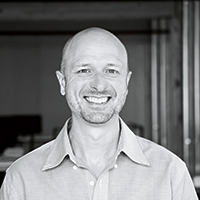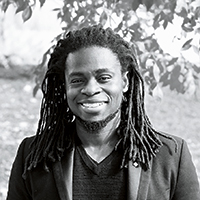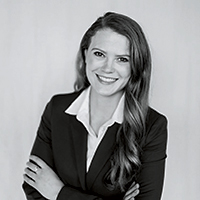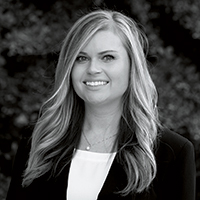
Leading While The World Waits
Tuesday, September 22, 2020
BY BRIDGET BURNHAM
These savvy alumni are building business models and products that can help their businesses—and their customers—thrive, even during a global pandemic.
The COVID-19 pandemic has shifted the pace and order of lives around the world—literally. Seismologists around the world have observed that the Earth is actually vibrating less as many of us take a step back to reprioritize and refocus, according to an article in Nature, among others. But, if you listen carefully, there is a steady hum of activity from people and organizations whose purpose and principles have put them in a position to accelerate, rather than slow down, during this crisis. Several Carlson School alumni are among the leaders the world is counting on to decide what needs to be done next and act.
Their stories illustrate the resiliency and determination that will carry us through this challenging time, and their impact is moving us toward a stronger, more connected, and more compassionate world.
Taking Telemedicine to the next level
Telehealth is in the spotlight for its role in providing care during coronavirus. Jon Pearce (’09 MBA), founder of Zipnosis, a white-label virtual care platform that powers virtual triage and visits for 51 large health systems across the country, is proving that a new model for virtual care can transform the future of healthcare.
Zipnosis saw an increase of 3,600 percent in utilization during the first 11 days of the COVID-19 crisis. While some telemedicine providers floundered with long wait times, the average wait time for a Zipnosis visit was just 10 minutes. When the CDC issued guidance around screening for COVID-19, Zipnosis immediately implemented a COVID-19 protocol and unique screener, quickly collecting critical data for patients, providers, and policymakers during the pandemic. With each success, Pearce is validating what was once only a theory: that the right technology, deployed at scale, can revolutionize how healthcare is delivered.
When he started Zipnosis in 2009, Pearce knew that the cell phone would be the clinic of the future. His belief in the potential for smart virtual care led him to leave his job at a medical technology startup to dive into the world of telemedicine while also studying at the Carlson School. With a robust understanding of healthcare’s challenges and an appreciation for how e-commerce was transforming consumer experiences, Pearce set out to build technology that would advance care while saving costs.
“Zipnosis started with the question, ‘How do we bring a consumer-grade interface into healthcare?’” Pearce says. “We looked at responsive, customer-centric platforms like Amazon and Stubhub and how we could modify the technology to fit healthcare needs and regulations.”
The “zip” in Zipnosis represents the consumer-focused component of the model that allows patients to access care wherever and whenever they choose by answering a series of questions designed to help providers assess and guide care. Although they can see a provider via video, telephone, or in-person, a large percentage of visits triaged through Zipnosis are delivered through asynchronous visits, meaning providers review patient answers on their own time and contact patients through the most appropriate channel to provide their diagnosis and treatment plan.
The second half of the company’s name comes from “gnosis,” the Greek word for knowledge, referring to Zipnosis’s use of data to help triage care minimize in-person contact when appropriate, and maximize capacity. Using smart technology on the front end of care reduces 99 percent of documentation for providers and helps drive costs down.
“Zipnosis started with the question, ‘How do we bring a consumer-grade interface into healthcare?’”
The rapid explosion of demand for virtual care has put a lot of pressure on health care companies, but Pearce is proud of how his team and the Zipnosis model have performed under stress.
“We scaled at historic rates in historic measure,” says Pearce. “We had intense moments, but the technology and the service withstood a historic stress test with an A-plus outcome when other methods didn’t.”
With proof that their tools for powering better virtual visits are working, there’s no stopping point in sight for the Zipnosis team. On June 15, the company rolled out ZipCheck, an end-to-end return-to-work solution that manages the ongoing COVID-19 screening, testing, treatment, and population management for employers looking to mitigate risk and protect employee and customer safety. The company also recently announced a partnership with Upfront Health, a patient communication and engagement platform designed to address health systems’ need to engage patients who have been delaying care and preventive visits because of COVID-19 by encouraging them to book necessary care.
“We have the technology and infrastructure to power every virtual visit and reinvigorate the healthcare system,” Pearce says. “This is the time to step up.”
Powering reliable primary care
Sometimes, the most significant mark of success is staying the course while everything around you changes. As other healthcare organizations struggled to anticipate and respond to peaks and lulls in demand during COVID-19, Nice Healthcare continues to run operations as planned. With the addition of new protocols and personal protective equipment, and a short pause on elective, preventive visits, Nice is still doing what they say they do best—providing convenient, affordable primary care to their members.
“A healthcare company shouldn’t benefit or suffer during a pandemic,” says Nice Healthcare CEO, Thompson Aderinkomi (’11 MBA). “People should have the same level of access to quality primary care at the same cost, no matter what.”
That belief in the importance of affordable, accessible primary healthcare for everyone led Aderinkomi and his co-founders to launch Nice Healthcare in 2017. The idea behind Nice is simple: Remove the complexity and intermediaries wherever possible and pass the cost savings on to the customer. With Nice’s model, employers purchase a membership plan that offers their employees and dependents unlimited video visits, chat visits, home visits, and in-home labs and X-rays for less than a dollar a day with no out-of-pocket fees. Nice even carries common prescription drugs and delivers them to employees at home or work.
To keep overhead and administrative costs low, Nice forgoes having a clinic in favor of in-home visits and does not accept insurance. It’s not just about simplicity, however. Nice strives to provide the highest level of patient satisfaction possible.
“We measure success by how the company affects the people it interacts with in the short term and the long term,” says Aderinkomi. “We’re not just trying to extract as much value as possible.”
The effects of Nice on members and employees during the pandemic have been positive. Whereas many healthcare consumers are skipping or delaying primary care visits, Nice members are on track with the number of visits the organization would have expected to see before the pandemic. And while many clinics in the primary care sector have had to furlough or lay off employees, Nice’s model provides a more predictable and secure revenue stream, and thus, more employment security. The company recently launched the Nice Return Program to help employers protect against COVID-19 at work with online assessments and live consultations with a Nice Healthcare provider.
“People should have the same level of access to quality primary care at the same cost, no matter what.”
While Aderinkomi remains focused on expanding the model he believes will improve access to affordable care, he hopes people will take a critical look at what else needs to change to make healthcare work better for more people.
“We need to ask, ‘Why is an industry that consumes 20 percent of our nation’s productivity laying people off?’” says Aderinkomi. “Where is that money going—and could we be spending it better?”
Developing a life-saving medical device within days
When Jim McGurran, (’17 MBA) got a call from his lifelong friend, Dr. Steven Richardson, a cardiac anesthesia fellow at the University of Minnesota, about an idea for a low-cost, scalable mechanical ventilator model to help patients with COVID-19, he was all in. The call happened on Sunday, March 15, and by the end of the day Monday, McGurran, a product development director at MGC Diagnostics, a Minnesota–based medical technology company, had his entire software team working on prototypes.
“When Steve called, I knew we had to get moving right away,” says McGurran. “We were facing a moment of unprecedented need and a very real threat to the healthcare system.”
The concept for the Coventor, as it would later be called, was relatively simple. The first iteration focused on adding an attaching an automated mechanism to an “Ambu” bag that paramedics and emergency medicine specialists use to manually resuscitate patients. But getting any product ready for FDA approval is far from easy.
McGurran’s previous involvement in the engineering and regulatory side of medical product development and his time in the Carlson School’s Medical Industry Leadership Institute (MILI) Valuation Lab, equipped him to efficiently gather and understand the requirements and take action quickly.
“A lot of what I learned in the MILI Lab came into play in my approach to this opportunity,” says McGurran. “We were identifying problems and roadblocks, finding component partners, and making build-or-buy decisions based on feedback and data.”
They were doing all of that at a very rapid pace. By Tuesday, March 17—just two days after his call with Dr. Richardson—McGurran’s team was ready to transfer the initial Coventor design to Protolabs for further development and testing.
“We were facing a moment of unprecedented need and a very real threat to the healthcare system.”
From there, other companies jumped in to help meet FDA requirements for things such as testing and labeling. Just a month after that initial call, on April 14, the University of Minnesota gained FDA Emergency Use Authorization for the Coventor.
“If you had asked me before March if it was possible to design and scale a medical device for the market within a month, I would have said no,” says McGurran. “But I’m always amazed by how resilient, creative teams can collaborate to solve problems.”
Feeding Minnesota's front line
Like many recent grads, Shannon Leach’s post-graduation plans look a lot different than she predicted. Fortunately, as a veteran of the constantly-changing food industry (she worked at Izzy’s Ice Cream for 13 years), she was prepared to pivot. So, when fellow alumni, Maggie Thomas, told her about an opportunity to help launch a local chapter of Frontline Foods, an open-sourced effort to deliver meals to hospital staff from local restaurants, she shifted her focus from job search to start-up mode. With her background in operations and her passion for food as a uniting force, Leach (’20 MBA) saw the brilliance in the Frontline Foods model.
“I saw how Frontline Foods and World Kitchen were able to quickly adapt to the changing needs during the crisis,” says Leach. “Feeding meals to people who need them while supporting local businesses brings communities together during this uncertain time.”
Leach knew she’d need help on the marketing side and immediately thought of Lizzy Ullyot (’21 MBA), whom she had met through their mutual volunteer work through Carlson 4 Community. Ullyot, whose internship had fallen through due to COVID-19, was excited to use her skills to make an impact while learning more about the food industry.
“I have always wanted to go into consumer packaged goods,” says Ullyot. “Shannon and I have a lot of complementary skills, so this was an exciting way for me to jump in and contribute while getting to learn from her background in the food industry.”
The two applied for and received a Sands Fellowship and launched the Twin Cities chapter of Frontline Foods in April. They fundraised and made connections with local restaurant owners and healthcare providers, eventually raising more than $93,000 and providing 6,800 meals purchased from 11 local restaurants to healthcare workers across Minnesota.
Frontline Twin Cities also responded to community needs following the unrest after the murder of George Floyd in Minneapolis, extending meal delivery to people who were protesting and cleaning up the damage to the city.
“Feeding meals to people who need them while supporting local businesses brings communities together during this uncertain time.”
Running with their lean team of two and a few volunteers, Leach and Ullyot were fueled by stories from the field. Leach recalls one community clinic who had set aside money to feed their staff, and after receiving meals from Frontline, was able to re-allocate those dollars back into the needs of the organization.
“Healthcare workers are putting in long hours under difficult conditions,” Leach says. “Providing them a global array of food brings joy and relief from the physical and emotional stress.”
Frontline also relieves pressure for restaurant owners who are trying to hold on as revenue slows.
“For restaurants running on razor-thin margins and trying to keep staff and stay out of debt, an order from Frontline from 100 to 300 meals helps keep them afloat while also keeping them connected to the community,” says Ullyot.
Angelo Giovanis, CEO and head chef at The Naughty Greek, says working with Frontline kept him in business and gave him hope during a dark time.
He says, “I will never forget the feeling I got when I saw the smiles and the desperation on people’s faces when I was handing out food. I felt human. Frontline made me feel human.”
Keeping that connection to human needs and community are core priorities for Leach, Ullyot, and Frontline as they move forward. Frontline recently announced that it will join World Central Kitchen, an established nonprofit that uses the power of food to heal and strengthen communities through times of crisis and beyond.
Leach plans to continue work with Frontline remotely as she relocates to Colorado in August to resume her job search for her next opportunity in operations in the natural foods industry. Ullyot will return to school in the fall with an even stronger desire to deploy her business skills to help the community.
“My experience with Frontline showed me how creative companies and organizations can use resources to help the community,” says Ullyot. “Wherever I go next, I want to keep that spirit of positive, focused collaboration to make the world better.”





